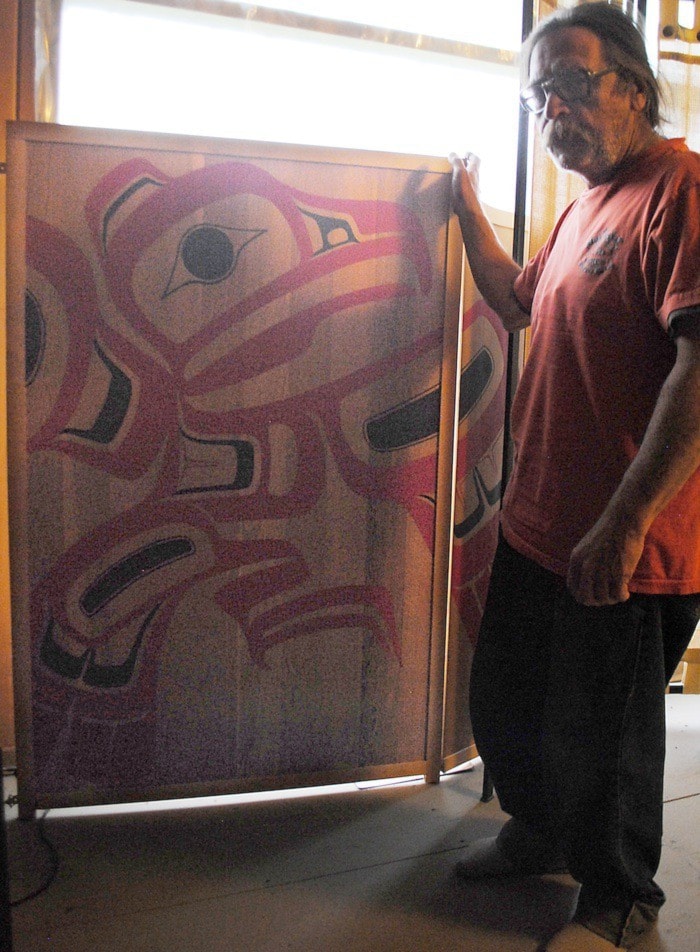Carl Phillip (Phil) Janze, a local Gitxsan artist, won a British Columbia First Nations’ Art award and $5000 for creative excellence and cultural contributions, Premier Christy Clark announced last week.
Janze said he learned how to carve and make jewelry by watching other artists work.
“It didn’t matter to me how big their name was, I learned something new every time.”
He does commissioned work as well as pieces he’s inspired to do, but they all have a similar fate.
“As soon as they’re finished, they go out the door,” Janze said.
“But I’ve gotten a bit slower these days.”
His love of traditional West-coast art began in 1963 in Bella Bella, mostly out of necessity.
“If we needed a bunch of spoons for a feast, well, I’d carve a bunch of spoons,” he said.
Early on Janze studied his predecessors
“I watched a couple of the older guys doing engravings and I was pretty impressed with that, so I tried it myself and liked it.”
Janze sells mainly out of art galleries in B.C. and believes his art has made it around the world.
Janze traces his ancestry on his mother’s side to France, where there is a county bearing his surname.
He claims Hugenot descent, which was a group of Protestants who followed John Calvin’s teachings, but due to persecution had to relocate to other parts of Europe.
Janze is part of the Lax Se’el (Frog Clan) and holds the name Luu’gan’iix, which means ‘brings wood in’, but it’s not originally Gitxsan.
“It was given to a Gitxsan Ha’lyt from people in the east as payment for killing a lightning snake,” Janze said.
He was told the snakes were about 10 metres long and ate people, so the Gitxsan medicine man was hired to kill the animal.
“No one will ever know what it looks like because he killed the last one.”
Janze was going to be a business administrator were it not for an economic downturn when he graduated from BCIT in 1970.
“That was the year the grads, around the world, never got hired,” Janze said.
“By the time the economy was better people had moved on to other things.”
He started carving full-time in 1972 after making the decision to stop working on a tug boat, which was dangerous at times, to be close to his wife, who had just found out she was pregnant.
“I just about got killed five times in one day, which normally didn’t bother me,” Janze said.
“But suddenly, I realized I was to be a dad and it bothered me.”
Janze wandered through Vancouver searching for a new career and happened upon one of the first art shops to sell Northwest coast art.
He didn’t have anything to offer the manager to view, but swore he would be back in a week.
“I took him about ten pendants that I had been working on,” Janze explained.
“By the time I left he had bout them all.”
Times and prices have changed a lot since then.
“I used to work all week to make $60 and now, if you can’t make that in a week, you’re going broke,” he said.
Silver was about 50 cents an ounce when Janze started and is now over $34 an ounce, he says.
Janze has shared his knowledge with more than 200 artists through the years like Ron Sebastian (Gitxsan/Wet’suwet’en), Don Yeomans (Haida) and Henry Greene (Tsimsian).
Janze was also part of helping another renowned Gitxsan artist, the late Walter Harris, Geel, to continue making art after Harris suffered from a stroke in the late seventies.
“I had to make tools that he could use, so he could engrave again,” he recalled.
“It was all new to him and he had to learn from scratch.”
Janze has had to fight off two strokes of his own.
One nearly blinded him, but the latest one had him in rehabilitation for over three months.
“I overcame the first one, but I had to lift weights for about eight hours a day for the last one,” Janze said.
“Plus I worked on a cabin in the Kispiox Valley, when I got home, that helped a lot.”
The cabin is on his family’s homestead near Pentz Lake, which he hopes to complete next year.
